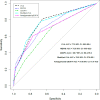Performance of the Universal Vital Assessment (UVA) mortality risk score in hospitalized adults with infection in Rwanda: A retrospective external validation study
- PMID: 35320314
- PMCID: PMC8942262
- DOI: 10.1371/journal.pone.0265713
Performance of the Universal Vital Assessment (UVA) mortality risk score in hospitalized adults with infection in Rwanda: A retrospective external validation study
Abstract
Background: We previously derived a Universal Vital Assessment (UVA) score to better risk-stratify hospitalized patients in sub-Saharan Africa, including those with infection. Here, we aimed to externally validate the performance of the UVA score using previously collected data from patients hospitalized with acute infection in Rwanda.
Methods: We performed a secondary analysis of data collected from adults ≥18 years with acute infection admitted to Gitwe District Hospital in Rwanda from 2016 until 2017. We calculated the UVA score from the time of admission and at 72 hours after admission. We also calculated quick sepsis-related organ failure assessment (qSOFA) and modified early warning scores (MEWS). We calculated amalgamated qSOFA scores by inserting UVA cut-offs into the qSOFA score, and modified UVA scores by removing the HIV criterion. The performance of each score determined by the area under the receiver operator characteristic curve (AUC) was the primary outcome measure.
Results: We included 573 hospitalized adult patients with acute infection of whom 40 (7%) died in-hospital. The admission AUCs (95% confidence interval [CI]) for the prediction of mortality by the scores were: UVA, 0.77 (0.68-0.85); modified UVA, 0.77 (0.68-0.85); qSOFA, 0.66 (0.56-0.75), amalgamated qSOFA, 0.71 (0.61-0.80); and MEWS, 0.74 (0.64, 0.83). The positive predictive values (95% CI) of the scores at commonly used cut-offs were: UVA >4, 0.35 (0.15-0.59); modified UVA >4, 0.35 (0.15-0.59); qSOFA >1, 0.14 (0.07-0.24); amalgamated qSOFA >1, 0.44 (0.20-0.70); and MEWS >5, 0.14 (0.08-0.22). The 72 hour (N = 236) AUC (95% CI) for the prediction of mortality by UVA was 0.59 (0.43-0.74). The Chi-Square test for linear trend did not identify an association between mortality and delta UVA score at 72 hours (p = 0.82).
Conclusions: The admission UVA score and amalgamated qSOFA score had good predictive ability for mortality in adult patients admitted to hospital with acute infection in Rwanda. The UVA score could be used to assist with triage decisions and clinical interventions, for baseline risk stratification in clinical studies, and in a clinical definition of sepsis in Africa.
Conflict of interest statement
The authors have declared that no competing interests exist.
Figures




Similar articles
-
Predicting mortality in adults with suspected infection in a Rwandan hospital: an evaluation of the adapted MEWS, qSOFA and UVA scores.BMJ Open. 2021 Feb 10;11(2):e040361. doi: 10.1136/bmjopen-2020-040361. BMJ Open. 2021. PMID: 33568365 Free PMC article.
-
Performance Assessment of the Universal Vital Assessment Score vs Other Illness Severity Scores for Predicting Risk of In-Hospital Death Among Adult Febrile Inpatients in Northern Tanzania, 2016-2019.JAMA Netw Open. 2021 Dec 1;4(12):e2136398. doi: 10.1001/jamanetworkopen.2021.36398. JAMA Netw Open. 2021. PMID: 34913982 Free PMC article.
-
A Prospective Comparison of Quick Sequential Organ Failure Assessment, Systemic Inflammatory Response Syndrome Criteria, Universal Vital Assessment, and Modified Early Warning Score to Predict Mortality in Patients with Suspected Infection in Gabon.Am J Trop Med Hyg. 2019 Jan;100(1):202-208. doi: 10.4269/ajtmh.18-0577. Am J Trop Med Hyg. 2019. PMID: 30479248 Free PMC article.
-
Comparison of qSOFA and Hospital Early Warning Scores for prognosis in suspected sepsis in emergency department patients: a systematic review.Emerg Med J. 2022 Apr;39(4):284-294. doi: 10.1136/emermed-2020-210416. Epub 2021 Aug 17. Emerg Med J. 2022. PMID: 34404680
-
Accuracy of quick Sequential Organ Failure Assessment (qSOFA) score and systemic inflammatory response syndrome (SIRS) criteria for predicting mortality in hospitalized patients with suspected infection: a meta-analysis of observational studies.Clin Microbiol Infect. 2018 Nov;24(11):1123-1129. doi: 10.1016/j.cmi.2018.03.032. Epub 2018 Mar 29. Clin Microbiol Infect. 2018. PMID: 29605565
Cited by
-
Factors Associated With Death at 30 Days and Evaluation of Clinical Risk Scores Among Patients With Cancer Admitted With Postchemotherapy Infection in Uganda: A Prospective Cohort Study.Open Forum Infect Dis. 2024 Oct 25;11(11):ofae634. doi: 10.1093/ofid/ofae634. eCollection 2024 Nov. Open Forum Infect Dis. 2024. PMID: 39553287 Free PMC article.
-
A narrative review of the pathophysiology of sepsis in sub-Saharan Africa: Exploring the potential for corticosteroid therapy.PLOS Glob Public Health. 2025 Apr 9;5(4):e0004429. doi: 10.1371/journal.pgph.0004429. eCollection 2025. PLOS Glob Public Health. 2025. PMID: 40202999 Free PMC article. Review.
-
Inability-to-walk-unaided-a single WHO danger sign predicts in-hospital mortality in people with HIV under routine care conditions in a low-resource setting.Ther Adv Infect Dis. 2025 Jun 5;12:20499361251341385. doi: 10.1177/20499361251341385. eCollection 2025 Jan-Dec. Ther Adv Infect Dis. 2025. PMID: 40487792 Free PMC article.
-
Outcomes of adults hospitalized with COVID-19 at the University Teaching Hospital of Butare in Rwanda and validation of the Universal Vital Assessment (UVA) mortality risk score.PLOS Glob Public Health. 2024 Dec 9;4(12):e0003695. doi: 10.1371/journal.pgph.0003695. eCollection 2024. PLOS Glob Public Health. 2024. PMID: 39652578 Free PMC article.
-
The Universal Vital Assessment (UVA) score at 6 hours post-resuscitation predicts mortality in hospitalized adults with severe sepsis in Mbarara, Uganda.PLOS Glob Public Health. 2024 Oct 22;4(10):e0003797. doi: 10.1371/journal.pgph.0003797. eCollection 2024. PLOS Glob Public Health. 2024. PMID: 39436893 Free PMC article.
References
Publication types
MeSH terms
LinkOut - more resources
Full Text Sources
Medical

